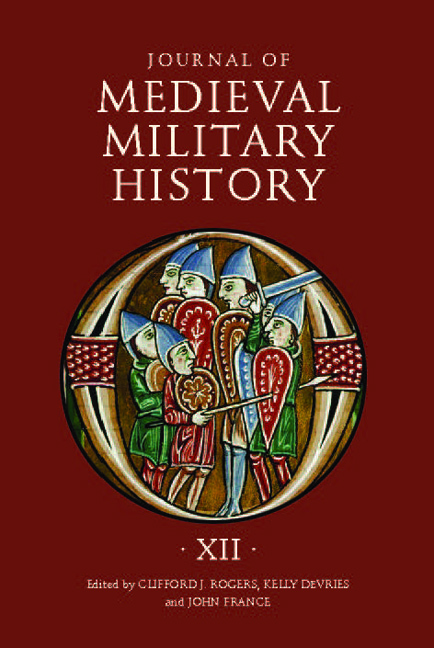Book contents
- Frontmatter
- Contents
- List of Illustrations and Map
- 1 Some Observations Regarding Barbarian Military Demography: Geiseric's Census of 429 and Its Implications
- 2 War Words and Battle Spears: The kesja and kesjulag in Old Norse Literature
- 3 The Political and Military Agency of Ecclesiastical Leaders in Anglo-Norman England: 1066–1154
- 4 Couched Lance and Mounted Shock Combat in the East: The Georgian Experience
- 5 The Battle of Arsur: A Short-Lived Victory
- 6 Prelude to Kephissos (1311): An Analysis of the Battle of Apros (1305)
- 7 Horse Restoration (Restaurum Equorum) in the Army of Henry of Grosmont, 1345: A Benefit of Military Service in the Hundred Years' War
- 8 The Indenture between Edward III and the Black Prince for the Prince's Expedition to Gascony, 10 July 1355
- 9 Investigating the Socio-Economic Origins of English Archers in the Second Half of the Fourteenth Century
- 10 War and the Great Schism: Military Factors Determining Allegiances in Iberai
- List of Contributors
- Journal of Medieval Military History 1477–545X
6 - Prelude to Kephissos (1311): An Analysis of the Battle of Apros (1305)
Published online by Cambridge University Press: 05 November 2014
- Frontmatter
- Contents
- List of Illustrations and Map
- 1 Some Observations Regarding Barbarian Military Demography: Geiseric's Census of 429 and Its Implications
- 2 War Words and Battle Spears: The kesja and kesjulag in Old Norse Literature
- 3 The Political and Military Agency of Ecclesiastical Leaders in Anglo-Norman England: 1066–1154
- 4 Couched Lance and Mounted Shock Combat in the East: The Georgian Experience
- 5 The Battle of Arsur: A Short-Lived Victory
- 6 Prelude to Kephissos (1311): An Analysis of the Battle of Apros (1305)
- 7 Horse Restoration (Restaurum Equorum) in the Army of Henry of Grosmont, 1345: A Benefit of Military Service in the Hundred Years' War
- 8 The Indenture between Edward III and the Black Prince for the Prince's Expedition to Gascony, 10 July 1355
- 9 Investigating the Socio-Economic Origins of English Archers in the Second Half of the Fourteenth Century
- 10 War and the Great Schism: Military Factors Determining Allegiances in Iberai
- List of Contributors
- Journal of Medieval Military History 1477–545X
Summary
Introduction
One of the most impressive military feats of the fourteenth century was the activity of the Great Catalan Company in the eastern Mediterranean area. Initially a band of mercenaries in the service of Frederick of Sicily (1295–1337) and then of the Byzantine Emperor Andronikos II Palaiologos (1282–1328), they turned into an autonomous fighting force against the Byzantines and settled permanently in the duchy of Athens. Their main strength and one of the principal reasons for their success lay in their military skills. They defeated the Turks in a series of battles; defeated the Byzantines at the battle of Apros; and took both the life and the duchy of the duke of Athens, Gautier I de Brienne (1308–1311) in the battle of Kephissos. This last battle is much acclaimed and well documented as it is deemed one of the first conflicts of the fourteenth century where an army of knights was defeated by a force on foot. Was Kephissos, however, the first time in the Company's turbulent history that the Catalans fought on foot and prevailed against a force of horsemen? A fresh analysis of the battle of Apros demonstrates that in all probability in 1305 a Byzantine force of horsemen was defeated by the Catalan foot soldiers. Thus, the objective of this paper is the examination of the Catalan art of war that culminated in the battle of Apros, which can be considered a most accurate foreshadowing of Kephissos.
- Type
- Chapter
- Information
- Journal of Medieval Military HistoryVolume XII, pp. 119 - 138Publisher: Boydell & BrewerPrint publication year: 2014

